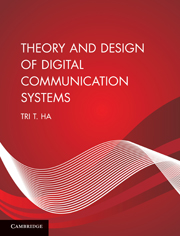Book contents
- Frontmatter
- Contents
- Preface
- Acknowledgements
- List of symbols
- List of abbreviations
- 1 Introduction
- 2 Deterministic signal analysis
- 3 Random signal analysis
- 4 Information theory and channel coding
- 5 Communication link analysis
- 6 Modulation
- 7 Demodulation
- 8 Spread spectrum
- 9 Intersymbol interference and equalization
- 10 Fading channels
- Index
- References
1 - Introduction
Published online by Cambridge University Press: 05 June 2012
- Frontmatter
- Contents
- Preface
- Acknowledgements
- List of symbols
- List of abbreviations
- 1 Introduction
- 2 Deterministic signal analysis
- 3 Random signal analysis
- 4 Information theory and channel coding
- 5 Communication link analysis
- 6 Modulation
- 7 Demodulation
- 8 Spread spectrum
- 9 Intersymbol interference and equalization
- 10 Fading channels
- Index
- References
Summary
If the mind is in tranquility, time and space cease to exist.
Essence of BuddhismBrief overview
This book provides the principles of digital communication and studies techniques to design and analyze digital communication systems for point-to-point and point-to-multipoint transmission and reception. Other than for radio broadcasting, modern communication systems are going digital, and in the USA the conversion of analog TV broadcasting into digital HDTV broadcasting at the beginning of 2009 signified the coming end of analog communications. Communications between living beings began with the voice, and the three biggest voice systems in the world are the telephone, and the cellular and radio broadcasting systems.
The dissemination of visual activities then propelled the development of TV broadcasting systems. The pioneer telephone network and radio broadcasting systems employed analog communication techniques, such as AM and FM, for transmission of analog voice, as did the analog TV broadcasting systems, which employed VSB-AM for picture transmission. The quality of the message, such as voice and images, at the analog receiver depends on how well the waveform that carries the message over the physical channel (twisted-pair telephone wires, coaxial and fiber-optic cables, space, and water) can be reproduced. In addition, the fidelity of the received message depends on the signal-to-noise ratio at the receiver input. For good analog communications, the signal-to-noise ratio must be large, and this requires high-power transmitters, such as are used in AM radio and TV broadcasting.
- Type
- Chapter
- Information
- Publisher: Cambridge University PressPrint publication year: 2010
References
- 1
- Cited by



